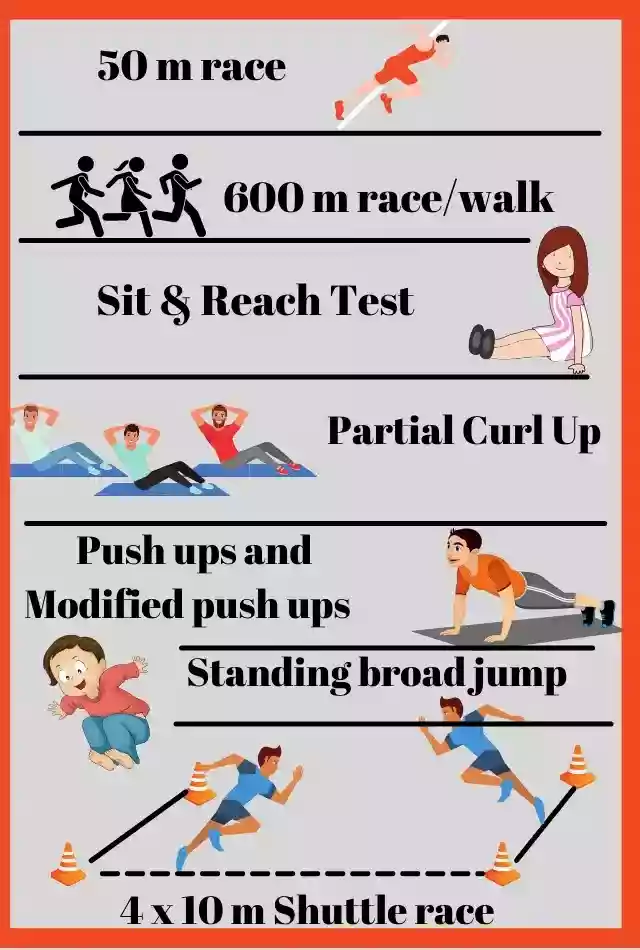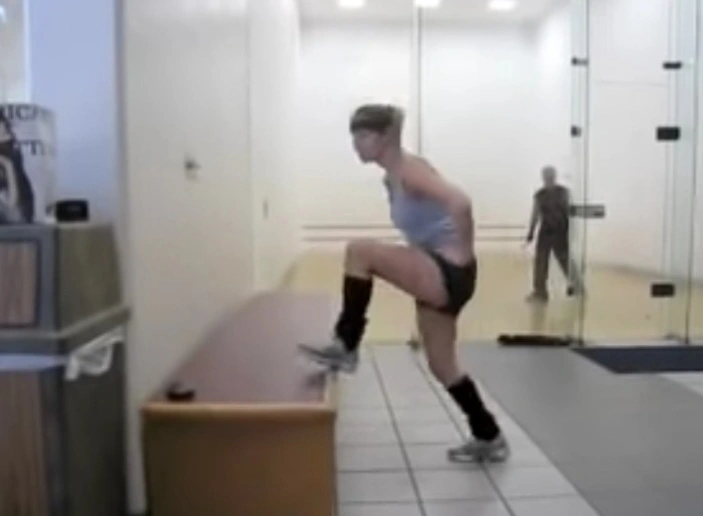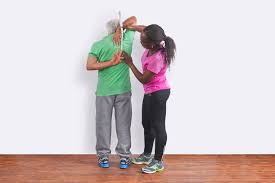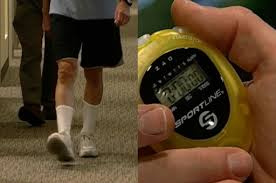
Test and measurement is the instrument for getting essential details regarding the needs, capacities, abilities and attitudes of students or sportspersons.
Every task and work needs to be evaluated. Evaluation is based uIpon test and measurement. This is very important to check the progress of an individual.
Test provides data or scores which can be measured and evaluated. A test helps to collect data which can be evaluated for further improvement.
In Physical Education Tests are used to collect information or data about a specific skill, strength, endurance, knowledge and attitude. And Measurement is related to measuring size, height, weight, vital capacity, achievement, etc.

These components are Strength, Endurance, Flexibility, Speed, Coordination/agility. Test to check these components are as follows
Test Items
50 M Standing Start
50m race is administered to test the athlete’s speed. This test includes running 50 meters as fast as possible.
Procedure
Stand behind the starting line without touching the ground. One foot in front of the other.
Once the subject is ready, the starter gives the instructions “set” then “go. The athlete starts and crosses the end line as fast as possible.
600m run/walk
This test is to measure the endurance level.
Procedure
Stands behind the starting line. At the signal Ready and Go, The athlete starts running. In between, he can run or walk. Time is recorded.
Sit and Reach Test
This test is conducted to measures the flexibility of the lower back and hamstring muscles.
Procedure
Sit on the floor without shoes, legs stretched, knee straight, palm facing downward. The subject tries to reach forward along the measure line as far as possible without giving any jerks
Partial Curl Up
The partial curl-up test is to test abdomen strength. The subjects perform as many sit-ups as possible at the rate of one every three seconds.
Procedure
Lie down on the back with the knees flexed. The subject curls up, until the shoulders come off the mat two inches, then go back again.
A total number of repetition of sit-ups is recorded in one minute.
Push Ups For Boys
This push-up test is to measure upper body strength and endurance.
Procedure
From prone position push whole body up, hands and toes touch the floor, the body and legs in a straight line, feet slightly apart, keep the back and knees straight,
Lowers the body to a 90-degree angle at the elbows, then returns to position, continue till exhaustion,
Modified Push Ups For Girls
The Modified Push-Up test is used to measure upper body strength, endurance and trunk stability
Procedure
Get down on your hands and knees with your hands just outside the shoulder. Now bend your elbows and lower your chest till 90° at the elbows.
Push your body up so that your arms are straight, the test will continues until exhaustion
Standing Broad Jump
The purpose of this test is to measure the explosive power of the legs.
Procedure
Stand behind a line marked on the ground with feet slightly apart. Now jump as far as possible, landing on both feet without falling backwards.
4×10 M Shuttle Run
This test measures agility and speed
Procedure
Stand behind the starting line. On the signal, go, sprint to the opposite line, which is marked 10 m away. Pick up one block of wood (two wood block kept behind the line beforehand), run back to starting position, place the block on or beyond the line.
Take turn without a rest, run back to get the second block and carry it back across the finish line. A total of 40 metre is covered.

Harvard step test was developed by Lucien Brouha and his associates in 1943.
This test is to measure the cardiovascular or Aerobic fitness of an athlete, by checking the recovery rate.
Requirements:
⛳One gym bench of 20 inches high for men and 16 inches for women
⏰ Stopwatch
Test Administration
In this test,
Athlete step-ups and step-down on the gym bench for five minutes or until exhaustion, at a rate of 30 steps per minute.
On the command ‘go’ an athlete starts doing steps, stopwatch is switched on simultaneously.
After completing athlete sits down immediately
Pulse 1: The assistant measures the total number of heartbeat counted for 30 sec after 1 min of completion.
Pulse 2: The assistant measures heartbeat again after 2 min for 30sec.
Pulse 3: The assistant measures pulse again after 3 minutes for 30 sec.
Calculation
100 x Test duration in seconds / 2x Sum of pulses
For male excellent score is above 90, and for women it is above 86
Rockport Walking Test
This test is to measure the Cardiorespiratory fitness of the athlete by measuring VO2 Max ( Maximum Cardiovascular Ability )
Requirements
Running track ( 200 – 400m )
⌚ Stopwatch
♨ Weighing machine
Assistant
Test Administration
– Record body weight in pounds
– Walk or run one mile (1609m) as fast as possible
– Record the time to complete the one-mile walk
– Immediately on finishing the walk measure heart rate
Calculation
The formula to calculate VO2 max is:
132.853 – (0.0769 × Weight) – (0.3877 × Age) + (6.315 × Gender) – (3.2649 × Time) – (0.1565 × Heart rate)
( Weight is in pounds (lbs)
Gender: Male = 1 and Female = 0
Time is expressed in minutes
Heart rate is in beats/minute
Age is in years)
Senior citizen fitness test was developed by Roberta Rikli and Dr. Jessie Jones. This test consists of six easy and simple tests that assess the functional fitness of senior citizens.
Click Below For Class 12 All Subject Sample Papers 2024
Chair Stand Test

This test is to check leg strength and muscle endurance.
Requirements
Straight back chair without arms 45 cm high, stopwatch.
Test Administration
Arm Curl Test

This test measures upper body strength and endurance. The aim is to do as many arm curls in 30 sec.
Requirements
Test Administration
Sit and Reach Test

The purpose of this test is to measure the lower body flexibility.
Requirements:
Ruler, Straight back chair 45 cm high
Test Administration
Back Scratch Test

This test measures the general range of motion of the Shoulder. It requires a ruler
Test Administration
8- Feet Up And Go Test

This test is designed to measure speed, agility and balance while moving
Requirements
Test Administration
6 Minute Walk Test

This test is to measure Aerobic fitness.
Requirements
Test Administration

The Johnson-Metheny Test battery is an updated version of the Johnson Educability Test developed back in 1932. It aimed to assess neuromuscular skill capacity through a set of ten specific items. In 1938, Methney made improvements by reducing the items to four key motor stunts: Front Roll, Back Roll, Jumping Half-Turns, and Jumping Full-Turns.
The testing area consists of a 15-foot long mat, divided into ten 18-inch sections with alternating ¾-inch and 3-inch transverse lines. Additionally, there’s a ¾-inch wide lengthwise line in the middle of the mat area
Here’s the procedure for each stunt:
1. Front Roll: Disregarding the central line, stand outside the marked area and execute two front rolls. The first roll should cover up to 7.5 feet, within the 3-inch-wide center line, and the second roll should cover the remaining 7.5 feet. It’s important to complete the rolls without touching the boundaries or exceeding the specified zones.
Scoring: You earn 5 points for each correctly performed roll, allowing a maximum of 10 points. If you go beyond the sideline (left or right) during either roll, 2 points are deducted for each instance. Going past the end limit during a roll results in a 1-point deduction for each occurrence. Failing to execute a proper front roll results in a full deduction of 5 points.
Back Roll: This test mirrors the front roll in execution and scoring. Start outside the marked chart area and execute two back rolls within the 2-foot lane area — the first back roll covering the first half and the second back roll covering the second half.
Jumping Half Turns: Begin standing with your feet on the first 3-inch line. Jump with both feet to the second 3-inch wide line while performing a half turn to the right or left. Then, jump to the third 3-inch line, executing a half turn in the opposite direction to your first half-turn. Continue to the fourth and fifth 3-inch wide lines, alternating half turns to the right and left.
Scoring: If you flawlessly execute four jumps, you earn ten points. Deduct only 2 points for each incorrect jump, like not landing with both feet on the 3-inch line or turning in the wrong direction, or both.
Jumping Full Turns: Start with your feet outside the marked area, positioned at the center of the lane. Jump with both feet together to the second rectangular space, executing a full turn to the right or left. Keep jumping to alternate rectangular spaces on the marked mat, performing full turns in the same direction, and ensure you land on both feet every time.
These tests are tailored for boys to perform four stunts and for girls to perform three stunts, each contributing to the assessment of neuromuscular skills.
Click Below To Learn Other Chapter Notes